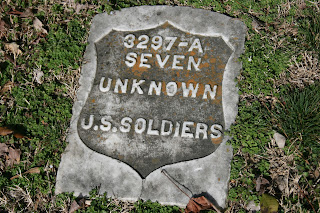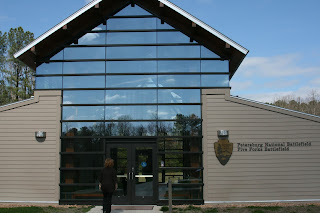The second day of our trip to Petersburg consisted of driving the 33 mile road which basically follows the earthwork lines of the opposing forces all the way to the Five Forks Battlefield, the western most site which is part of the park. Along the way we passed the remains of a number of trenches, embankments, and forts.
The picture above is of a site which was known as Fort Fisher. It was the largest earthwork fortification on the Petersburg front. On April 2, 1865 Union forces assaulted the Confederate lines just west of Fort Fisher and achieved a breakthrough.
Just to the southeast of Fort Fisher is the Poplar Grove National Cemetery which was established in 1866 for Union soldiers who died during the Petersburg and Appomattox campaigns. It is the location of the Western Front Visitors Center which is open only during the summer.
As fate would have it, when we reached the Five Forks Battlefield Visitors Center the ranger at that location is assigned to Poplar Grove during the summer. She had some great stories about the cemetery. One of the strangest has to do with the grave markers. Originally national cemeteries were under the supervision of the army, but in the 1930s they were transferred to the National Park Service. Funds were not forthcoming to keep the cemeteries in good condition. The Superintendent of Poplar Grove decided to cut the granite markers in half and place the remaining granite face up lying flat on the ground. He then sold the other half of the markers to a local businessman to build a house. The result of this "brilliant" decision is that the markers, lying face-up in the ground, have weathered poorly.
Along the way to Five Forks we came upon a small area called the White Oak Road Battlefield owned and maintained by the Civil War Preservation Trust. The trust raises money to obtain and maintain Civil War battle sites outside the boundaries of the national parks. The Trust had constructed a half mile loop trail with displays that explain the White Oak Road battle. It was very well done and gave us a chance to walk the dogs and enjoy a beautiful Spring day.
Our last stop was the Five Forks Battlefield. In this battle the Union forces were able to capture the South Side Railroad which was the last remaining rail line supplying Petersburg. The Union was led by Philip Sheridan. George Pickett was in command of the Confederates. It seems that at the time of the Union assault Pickett had withdrawn from the front lines to have a lunch of shad some two miles behind the lines. One of the Union leaders was George Armstrong Custer. The battlefield featured a new visitors center and some wonderful forest trails. We took a 1 1/2 mile hike to a pond that was a bird sanctuary.
One of the things we didn't do on this trip was to visit downtown Petersburg, which despite the siege and shelling still retains a number of Civil War era buildings including a Siege Museum and Farmers Bank Museum. The is a 68-stop auto tour of Civil War Petersburg that we'll catch next trip.





No comments:
Post a Comment